List of Naga tribes
Naga is a vaguely defined umbrella term for several tribes in North-East India and Upper Burma.
S. R. Tohring (2010) lists 66 Naga tribes.[1] The 1991 Census of India listed 35 Naga groups as Scheduled Tribes: 17 in Nagaland, 15 in Manipur and 3 in Arunachal Pradesh.[2]
In the past, writers such as Dr. Rev Dozo (in The Cross over Nagaland) and Renthy Keitzar, have classified the Kuki as one of the Naga tribes.
Naga tribes
| SN | Tribe | Traditional territory | Recognized as Scheduled Tribe in | Reference for classification as Naga | Population[3] | Comments |
|---|---|---|---|---|---|---|
| 1 | Angami | India | Nagaland | S. R. Tohring, 2010 | 132,000 | |
| 2 | Ao | India | Nagaland | S. R. Tohring, 2010 | 261,000 | |
| 3 | Chang | India | Nagaland | S. R. Tohring, 2010 | 62,4000 | |
| 4 | Chirr | India | Nagaland | S. R. Tohring, 2010 | ? | |
| 5 | Chiru | India | Manipur | S. R. Tohring, 2010 | ? | |
| 6 | Htangan | Burma | S. R. Tohring, 2010 | ? | ||
| 7 | Kharam (also Purum) | India | Manipur | S. R. Tohring, 2010 | 1,400 | |
| 8 | Khiamniungan (or Khiamnungam) | Burma, India | Nagaland | S. R. Tohring, 2010 | 37,800 | Nokaw (Noko) founded in Burma is also a Khiamniungan tribe. |
| Konyak | Burma, India | Nagaland | S. R. Tohring, 2010 | 248,000 | ||
| 10 | Leinong (also Lainong or Lainung) | Burma | S. R. Tohring, 2010 | 7,000 | ||
| 11 | Liangmai (also Liangmai or Lingmai) | India (Tamenglong, Manipur) | Manipur, Assam (under Community Zeliangrong) | S. R. Tohring, 2010 | 34,200 | Also known as Koireng (or Quireng) — not to be confused with the Koireng Kukis |
| 12 | Lotha | India | Nagaland | S. R. Tohring, 2010 | 170,000 | |
| 13 | Makury (sometimes spelt Makuri) | Burma | Nagaland | S. R. Tohring, 2010 | 2,500 | |
| 14 | Mao (also Ememei) | Senapati district, Manipur and Kohima and Dimapur districts, Nagaland (India) | Manipur | S. R. Tohring, 2010 | 81,000 | Also called Shiipfomei together with Poumai[4] |
| 15 | Maram | Senapati district (India) | Manipur | S. R. Tohring, 2010 | 37,3000 | |
| 16 | Maring | Chandel district (India) | Manipur | S. R. Tohring, 2010 | 22,300 | |
| 17 | Mzieme | Nagaland | William Frawley, 2003[5] | 29,000 | ||
| 18 | Nokaw (or Noko) | Burma | S. R. Tohring, 2010 | ? | Now they are known as Khiamniungan tribe. | |
| 19 | Nocte (or Nokte) | India | Patkai hills of Tirap district, Arunachal Pradesh. | S. R. Tohring, 2010 | 33,000 | It is a sub-tribe of Tangshang Naga. |
| 20 | Para | Burma | S. R. Tohring, 2010 | ? | ||
| 21 | Pochury | India | Nagaland | S. R. Tohring, 2010 | 16,700 | |
| 22 | Phom | India | Nagaland | S. R. Tohring, 2010 | 123,000 | |
| 23 | Poumai | Senapati District, Manipur and Phek district, Nagaland (India) | S. R. Tohring, 2010 | 1,50,000 | ||
| 24 | Puimei (Inpui or kabui) | India (Manipur and Assam) | William Frawley, 2003[5] | 3,000 | Not to be confused with Poumai | |
| 25 | Rengma | India | Nagaland | S. R. Tohring, 2010 | North-13000, South-21000 | |
| 26 | Rongmei | India | Assam, Manipur and Nagaland | S. R. Tohring, 2010 | 90,372 | Rongmei are part of Major Community called as Zeliangrong |
| 27 | Sangtam | India | Nagaland | S. R. Tohring, 2010 | 84,300 | |
| 28 | Sumi (or Sema) | India | Nagaland | S. R. Tohring, 2010 | 104,000 | |
| 29 | Tangkhul | Ukhrul district (India), Burma | Manipur | S. R. Tohring, 2010 | India-142,000, Myanmar-4,000 | |
| 30 | Tangshang (or Tase in language coding name) | India, Burma | Arunachal Pradesh, Burma | S. R. Tohring, 2010 | ? | Formerly known as Pangmi and Heimi (Haimi in Burma; and Rangpang, Tangsa, Wancho, Nocte, Tutsa in India. |
| 31 | Tarao | India | S. R. Tohring, 2010 | 870 | ||
| 32 | Thangal | India (Mao and Sadar Hills, Manipur) | S. R. Tohring, 2010 | 23,600 | ||
| 33 | Tikhir | India | Nagaland | S. R. Tohring, 2010 | ? | |
| 34 | Tutsa | India | Robin Tribhuwan, 2005[6] | 25,5000 | It is a sub-tribe of Tangshang Naga. | |
| 35 | Wancho | India | Arunachal Pradesh | S. R. Tohring, 2010 | 49,100 | It is a sub-tribe of Tangshang Naga. |
| 36 | Yimchunger | Burma, India | Nagaland | S. R. Tohring, 2010 | 92,100 | |
| 37 | Zeme | India: Tamenglong, Senapati districts (Manipur); Peren district (Nagaland); NC Hills district (Assam) | Zeliang in Nagaland, Zeme in Assam & Manipur | S.R.Tohring | 34,100 | Zeme is a part of Zeliangrong Community |
-
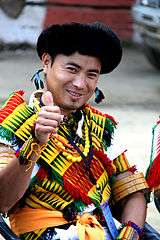
An Angami man in traditional dress
-

Ao woman in traditional attire
-
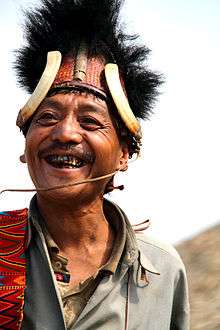
A Konyak chief in his traditional outfit
-
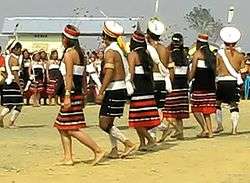
Liangmai youths performing folk dance during Road Show in Peren, Nagaland
-

A Pochury woman on a book cover
-
A diorama of Nocte people in a museum
-

Glory Day celebration of the Poumai Naga
-
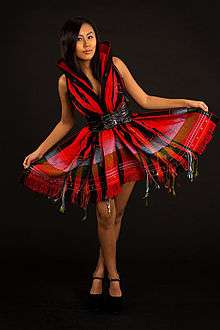
Tangkhul girl in a modern adaptation of the traditional dress
-
A diorama of Tangsa people in a museum
-
A diorama of the Wancho people in a museum
-
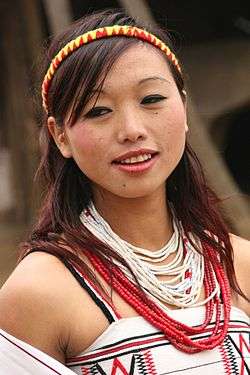
Yimchunger girl at the Kutur village morung
Tribes sometimes classified as Naga
| Tribe | Traditional territory | Recognized as Scheduled Tribe in | Reference for classification as Naga | Population | Comments |
|---|---|---|---|---|---|
| Anal | Chandel district (India), Burma | Manipur | S. R. Tohring, 2010 | Also classified as Kuki[7] | |
| Chothe | India | Manipur | S. R. Tohring, 2010 | Also classified as Kuki-Chin[7] | |
| Inpui | India | S. R. Tohring, 2010 | |||
| Khoibu | India | Manipur | Romesh Singh, 2006[8] | Recognized as a sub-tribe of Maring by some; however, they have a different origin and dialect | |
| Lamkang (also Lamgang or Langang) | Tengnoupal district (India) | Manipur | S. R. Tohring, 2010 | ||
| Monsang | Tengnoupal district (India) | Manipur | S. R. Tohring, 2010 | Not to confused with the sub-tribe of Tangshang Naga called, 'Moshang or Mossang' | |
| Moyon | Tengnoupal district (India), Burma | Manipur | S. R. Tohring, 2010 | Linguistically, the Moyons are closer to the Chin-Kuki-Mizo tribes, and have been classified as an "Old Kuki" tribe in the anthropological literature. However, now, they prefer to place themselves within the Naga fold.[9][10][11] |
Composite tribes or communities
- Chakhesang: Chakru, Kheza and Sangtam combined[4]
- Kabui: Rongmei and Inpui together[4]
- Shepfomei or Shepoumai (Mao-Poumai): Ememei, Lepaona, Chiliivai and Paomata together[4]
- Zeliangrong: Zeme, Liangmai and Rongmei together[7]
- Zeliang: Zeme and Liangmei together are called Zeliang in Nagaland[2]
- Tangshang: A combination term, Tang from Tangnyu Vang (Wang) and Shang from Shangnyu Vang (Wang) chieftains, which were formerly known as and includes Heimi (Haimi), Pangmi, Rangpang, Tangsa, Wancho, Nocte, and Tutsa now.
References
- ↑ S. R. Tohring (2010). Violence and identity in North-east India: Naga-Kuki conflict. Mittal Publications. pp. xv–xvii. ISBN 978-81-8324-344-5.
- 1 2 U. A. Shimray (2007). Naga population and integration movement. Mittal Publications. pp. 25–33. ISBN 978-81-8324-181-6.
- ↑ http://www.ethnologue.com/
- 1 2 3 4 William Nepuni (2010). Socio-cultural history of Shüpfomei Naga tribe. Mittal Publications. pp. 24–25. ISBN 978-81-8324-307-0.
- 1 2 William Frawley (1 May 2003). International Encyclopedia of Linguistics. Oxford University Press. pp. 1–. ISBN 978-0-19-513977-8. Retrieved 8 September 2013.
- ↑ Robin D. Tribhuwan (1 January 2005). Tribal Housing Issues. Discovery Publishing House. pp. 56–. ISBN 978-81-7141-917-3. Retrieved 8 September 2013.
- 1 2 3 G. K. Ghosh, Shukla Ghosh (1997). Women of Manipur (illustrated ed.). APH Publishing. p. 4. ISBN 978-81-7024-897-2.
- ↑ M. Romesh Singh (1 January 2006). Tribal Development in 21st Century: An Experience from Manipur. Mittal Publications. pp. 60–. ISBN 978-81-8324-150-2. Retrieved 8 September 2013.
- ↑ Sipra Sen (1992). Tribes and Castes of Manipur: Description and Select Bibliography. Mittal Publications. p. 58. ISBN 978-81-7099-310-0.
- ↑ Folk tales of Moyon-Monsang. Directorate for Development of Tribals and Backward Classes, Manipur. 1982. p. 1.
- ↑ G. K. Ghosh, Shukla Ghosh (1997). Women of Manipur. APH. p. 54. ISBN 9788170248972.